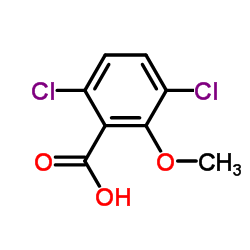Dicamba

Dicamba structure
|
Common Name | Dicamba | ||
|---|---|---|---|---|
| CAS Number | 1918-00-9 | Molecular Weight | 221.037 | |
| Density | 1.5±0.1 g/cm3 | Boiling Point | 326.1±37.0 °C at 760 mmHg | |
| Molecular Formula | C8H6Cl2O3 | Melting Point | 112-116 °C(lit.) | |
| MSDS | Chinese USA | Flash Point | 151.0±26.5 °C | |
| Symbol |


GHS05, GHS07 |
Signal Word | Danger | |
|
Quantitative structure-activity relationship and complex network approach to monoamine oxidase A and B inhibitors.
J. Med. Chem. 51 , 6740-51, (2008) The work provides a new model for the prediction of the MAO-A and -B inhibitor activity by the use of combined complex networks and QSAR methodologies. On the basis of the obtained model, we prepared and assayed 33 coumarin derivatives, and the theoretical pr... |
|
|
Enhancing T-DNA Transfer Efficiency in Barley (Hordeum vulgare L.) Cells Using Extracellular Cellulose and Lectin.
Appl. Biochem. Biotechnol. 176 , 1203-16, (2015) A major limitation of transforming barley tissues by Agrobacterium tumefaciens is the low frequency of T-DNA transfer due to recalcitrance of barley as a host. The effect of extracellular cellulose and lectin on Agrobacterium transformation efficiency was inv... |
|
|
GH3 expression and IAA-amide synthetase activity in pea (Pisum sativum L.) seedlings are regulated by light, plant hormones and auxinic herbicides.
J. Plant Physiol. 170(4) , 361-8, (2013) The formation of auxin conjugates is one of the important regulatory mechanisms for modulating IAA action. Several auxin-responsive GH3 genes encode IAA-amide synthetases that are involved in the maintenance of hormonal homeostasis by conjugating excess IAA t... |
|
|
Phenoxy herbicides and fibrates potently inhibit the human chemosensory receptor subunit T1R3.
J. Med. Chem. 52 , 6931-5, (2009) We show that phenoxyauxin herbicides and lipid-lowering fibrates inhibit human but not rodent T1R3. T1R3 as a coreceptor in taste cells responds to sweet compounds and amino acids; in endocrine cells of gut and pancreas T1R3 contributes to glucose sensing. Th... |
|
|
Generation of amphidiploids from hybrids of wheat and related species from the genera Aegilops, Secale, Thinopyrum, and Triticum as a source of genetic variation for wheat improvement.
Genome 58 , 71-9, (2015) We aim to improve diversity of domesticated wheat by transferring genetic variation for important target traits from related wild and cultivated grass species. The present study describes the development of F1 hybrids between wheat and related species from th... |
|
|
Treatment of 2,4-D, mecoprop, and dicamba using membrane bioreactor technology.
Environ. Sci. Pollut. Res. Int. 20(8) , 5188-97, (2013) Phenoxyacetic and benzoic acid herbicides are widely used agricultural, commercial, and domestic pesticides. As a result of high water solubility, mobility, and persistence, 2,4-dichlorophenoxyacetic acid (2,4-D), methylchlorophenoxypropionic acid (mecoprop),... |
|
|
Clinical characteristics of patients after dicamba herbicide ingestion.
Clin. Toxicol. (Phila.) 52(1) , 48-53, (2014) Despite a widespread use of dicamba herbicide and numerous animal model studies, there had not been studies on acute toxicity of this chemical compound in human subjects following ingestion. Therefore, this study was conducted to investigate clinical characte... |
|
|
Determination of chlorinated acid herbicides in vegetation and soil by liquid chromatography/electrospray-tandem mass spectrometry.
J. AOAC Int. 90(5) , 1402-10, (2007) The method presented uses reversed-phase liquid chromatography with negative electrospray ionization and tandem mass spectrometry to analyze 9 chlorinated acid herbicides in soil and vegetation matrixes: clopyralid, dicamba, MCPP, MCPA, 2,4-DP, 2,4-D, triclop... |
|
|
Physiological effects of temperature and a herbicide mixture on the soft-shell clam Mya arenaria (Mollusca, Bivalvia).
Environ. Toxicol. Chem. 30(1) , 132-41, (2011) The aim of the current study was to investigate effects of temperature and a mixture of herbicides on the physiological status of the bivalve Mya arenaria. Bivalves acclimated to two temperatures (7 and 18°C) were exposed for 28 d to 0.01 mg/L of a pesticide ... |
|
|
Dissipation of six acid herbicides in water and sediment of two Canadian prairie wetlands.
Environ. Toxicol. Chem. 30(9) , 1982-9, (2011) In the present study, an ephemeral (E) and a semipermanent (SP) wetland were divided into halves using a polyvinyl curtain and one-half of each wetland was treated with dicamba (3,6-dichloro-o-anisic acid), bromoxynil (3,5-dibromo-4-hydroxy-benzonitrile), MCP... |